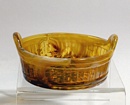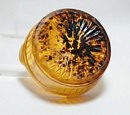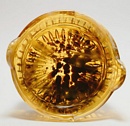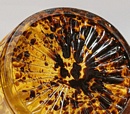Sowerby Tortoiseshell Glass
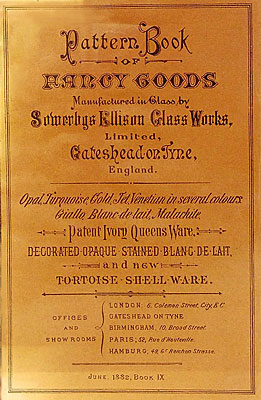
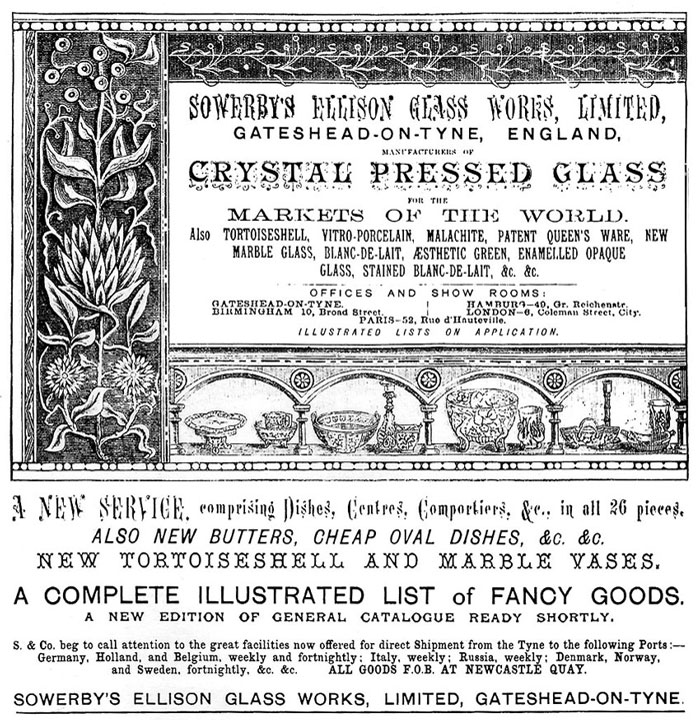
The front cover of the Sowerby 1882 catalogue refers to New Tortoise Shell Ware.
'New Tortoiseshell and marble Vases' are mentioned in a Pottery Gazette advertisment from 1882.
There are references to Tortoiseshell glass in the standard pressed glass texts but none of the authors seem to have seen a piece and there are no photographs of this type of glass.
Cottle, (Page 58) Sowerby's Gold is a typical transparent amber colour. A second darker amber added to a common amber batch produced, in 1882, Tortoiseshell, of which few examples survive.
Cottle, (Page 79) refers to an an exhibition held in Manchester in 1882 the reporter states:
'.... a very remarkable section of the exhibits was that occupied by articles in imitation of tortoiseshell and there are only one or two sets of specimens in the room that more clearly show what the new system of combining colours can do. A set of bowls and cups is made of the new interleaved glass and it is only when they are closely handled that the visitor can say they are not really tortoiseshell'
'The operations connected with the perfecting of the tortoiseshell glass occupied a period of seven months and in one week the meltings of metal made in the experiments were 81 in number.'
Slack, (Page 40) 'In July 1882 a summer novelty was introduced under the name of Tortoiseshell Glass, and was reported as 'very pretty and attractive. It's imitation of the real shell is striking, and being brought out at a popular price it must have a large sale'.
Hajdamach, (Page 342) Amber glass was made in two shades, a light version called Gold and a darker shade, made in 1882, called Tortoiseshell.
Hajdamach, (Page 307) There is reference to an English patent from 25 October 1880 by F. Pohl and S.A. Wittmann
'Ornamenting glass in imitation of tortoiseshell.
Bulbs of dark and light brown glass are blown, and broken into fragments. A bulb of plain glass is then blown, and its top is cut off from the part which adheres to the blowpipe.
Another bulb is rolled while hot in fragments of brown glass, and, with these adhering to it, is inserted in the cut-off portion, and the two qre blown together.
The whole is reheated, swung, drawn out, and formed into articles. These are then coated with solution of silver chloride and yellow ochhre or other materials for producing a yellow stain and are afterwards fired.'
The 1882 exhibition report mentioned in Cottle states that 'a set of bowls and cups is made of the new interleaved glass' unfortunately it does not say exactly how they were made.
The patented process above is a complicated process but one which shows fragments of dark and light brown glass being used to produce the tortoiseshell effect. The patent describes how the item is made by blowing glass, most tortoiseshell glass, certainly of this period seems to be produced in this way.
The pieces described below are Sowerby, both of which I believe are examples of the Tortoiseshell Glass described in the 1882 pattern book and Pottery Gazette advertisement.
The glass is an unusual dark amber, similar to Sowerby Gold glass in colour. The feet and sided are the dark amber colour with no tortoiseshell effect. The tortoishell effect is confined to the bottom of the piece, the feet and the sides are plain dark amber. If a gather of molten glass had had it's end dipped into flakes in different shades of amber before being dropped into the metal mould and subsequently pressed, the flakes would be in the bottom of the mould in the feet. They are not. It almost looks as if it has been built up in layers with a layer of the amber glass at the bottom to fill the feet, followed by a layer of 'flakes' of glass in different shades of amber, then another layer of clear amber with a couple of pieces of white thrown in before the article was finally pressed. Not sure if this is even possible, maybe someone can enlighten me.
This piece is a translucent, pale amber colour. The amber is much lighter than in ST1, more a light caramel colour. Again there are 'flakes' in different, darker, shades of amber at the bottom of the base. Where ST1 has flakes in the base, this time some of the flakes have migrated to the lower sides of the article. Also, where ST1 has just a couple of white streaks in the base and on one side, this piece has white streaks on the top of the inside and right through the sides of the glass. This looks similar to the mix on Sowerby malachite glass, but it is very unusual to find a translucent malachite made by Sowerby's. Overall the mix and colours on this piece give a more convincing tortoiseshell effect.
Both of the above items are pressed which is an unusual and probably much more difficult way of making glass with inclusions.
It looks like Sowerby's had high hopes for this glass but it seems to have almost disappeared without trace and is very rare.
There is a topic on the Glass Message Board about Sowerby Tortoiseshell Glass: 'GMB - Sowerby Tortoiseshell Glass'







